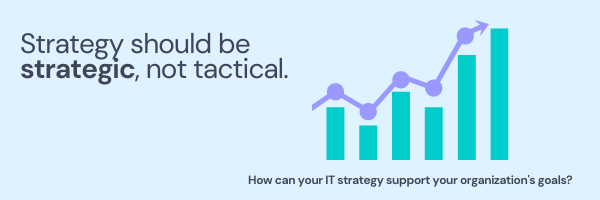IT Strategy: The Definitive Guide for Associations

You already know that if you don’t keep up with technological innovation and growing digital expectations, your member experiences will suffer. But do you have an actual plan for how to use an IT strategy to your advantage? Or, like most associations, are you struggling to begin?
If you’re nodding your head, then you’ve come to the right place. This is the ultimate guide to developing, writing, and executing a strategy that creates organizational value. We’ll start with the basics and then dig into the general development process, an example plan, and finally, wrap up with some tips and best practices.
What is an IT strategy?
Your strategy is a document that defines your IT vision and aligns with your greater organizational objectives and operations.
More importantly, it answers this question: How will we use IT to advance the goals, strategic plans, and value of our association?
So, if you’re struggling to define digital transformation questions like…
- What is our IT vision?
- What opportunities in the digital world should we tackle?
- And what’s the best way to use our technology resources to create value?
...then you should probably go ahead and write a strategy.
How to create an IT strategy
The strategy development process
Outline overall association goals
Your IT strategy and association strategy should complement each other. This means you’ll need to consider your association’s goals and overall vision.

Speak with staff and members
Speak with your internal team and members to extrapolate common themes and begin creating an IT strategy framework. Consider using individual interviews, surveys and questionnaires, and departmental interviews when collecting information.
Everyone within your association should understand the importance and purpose of your tech strategy. Make sure to express how this process affects different organizational functions.
Review existing infrastructure
Review what’s in your existing IT corner so you can pinpoint gaps and opportunities. Ask yourself: How do your departments and teams use technology? What software, tools, and systems do they use? What is working? What isn’t? What changes are needed to support your vision?
When you think critically about your current structure, you’ll be able to develop an IT plan based on the resources you already have or determine if you can save money and time by switching to new infrastructure or IT service providers.
Define schedule & scope
Establish the lifespan of your strategy. Define key phases, such as implementation, integration, review, etc.
Create IT roadmap for infrastructure
Define your planned technology infrastructure (hardware, software, and other tools) and rollout timeframes. Consider department-specific technology, as well as how your association's infrastructure fits together.
The technology you use for membership management, learning management, and event management should be integrated. Centralizing your data gives you a more holistic view of your members, so you can provide consistent value throughout their member journey.

Resource allocation
Consider who will do the work and what human resources will be needed.
When writing your strategy document, you’ll need to detail the IT organizational structure and human resources for your plan: What will your structure be? How will each piece be managed? Are extra staff and departments needed? Does anyone need to be repurposed?
Define metrics
You want to make sure your strategy is cost-effective and functional, right? To do so, you should identify your KPIs and key metrics to analyze the performance of your technology strategy over a given period of time.
These metrics may include member satisfaction and feedback, budget, efficiency indicators, etc.
Keep strategy up to date
Once you’ve created your technology strategy, continually update the plan as aspects of your association change.
Components of IT strategy
Below is an example table of contents and IT strategy plan template that you can use as a starting point. Adjust this IT strategy template as needed.

Section 1. How IT aligns with organizational goals
List your association’s goals for the next five years. Then, explain how your tech strategy will help meet those goals.
Section 2. Coverage period
Define how long your strategy will remain in effect. Your IT plan should be at least a five-year plan, which you should revisit annually. These yearly updates will allow you to make necessary adjustments and corrections.
Section 3. Limitations & Requirements
Discuss what considerations you took into account when developing your strategy. Do you have an event coming up? Do you expect some disruptions in your plans? Anything that may affect your strategy should be included.
Section 4. IT Vision Statement
Remember your strategy is strategic, not tactical. Talk about the “whats” and “whens” of your IT vision, rather than the “hows” of getting it done. What needs to change in IT to meet your goals?

Section 5. Initiative description & prioritization
List all projects and deliverables by importance and priority. These initiatives should, of course, align IT with your association goals AND bring your strategy to life.
Be sure to include high-level, bird’s eye justification for each initiative, as well. What happens to your strategy when unexpected projects surface? How will your plan react?
Section 6. Project Timeline
Outline the timelines for project delivery. When can you expect to see results? As your IT strategy progresses throughout the five years, project windows will narrow and become more specific.
Section 7. Necessary resources
List what cross-departmental employees, IT staff, skills, know-how, and structures will be required to employ your strategy.
Section 8. Tech and Processes
What technological infrastructure and processes are needed, and when?
Consider special circumstances here, as well. With more of your employees working online, different lines of communication and network infrastructure will be needed.
Maybe you’re migrating infrastructure to the cloud. If so, you will need to list what technologies and processes you’ll need for the migration. Then consider when and how to deploy your technologies and processes.

Section 9. How you’ll manage IT
Detail your plan for managing this IT strategy, including what staff, management, and departments will be needed or shifted.
Section 10. Projected budgets
Discuss planned budgets and actual costs for digital and IT initiatives over the next five years. These should be detailed for years 1-2 and estimated for years 3-5.
Final step: the sign-off
Now it’s time to get the green light from management. But since the CEO, CIO, and department leaders should have already been involved throughout the process, this step should be fairly simple.
Once your IT strategy is given the OK, use it to guide your IT governance, rollout, and management.
Best practices
- Align your strategy with your organizational strategy.
- Your strategy should be created in conjunction with and approved by management.
- Avoid creating short one-year IT plans. These end up implementing tactics, not strategy.
- Don’t let your strategy “sit on the shelf.”
- Remember building a strategy is an ongoing process, not a one-time project.
- Allow resources and budget for strategy updates each year.
- Plan for bigger change (aka the ongoing process) while working each strategic initiative.
The Wrap Up
Long story, short: creating an IT strategy will help you realize your association’s vision, strategy, and value. So what are you waiting for?
Take a technology assessment to get started with a “big-picture” view of your organization’s technology.



